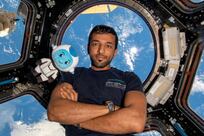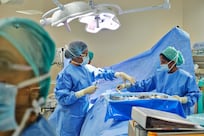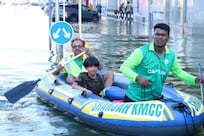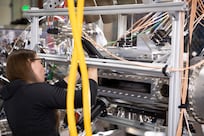The abandoned fairground in Tripoli is only semi-public and we had to badger the guard to let us in. He suggested we visit the newer, smaller, and bland public park across the street, built by the Saudis. But that park hadn't been designed by Oscar Niemeyer in the decade before Lebanon's civil war, so two friends and I insisted, answering questions about our nationalities and motivation. "We just want to look," I said "and take some pictures. We're interested in the architecture."
This sufficed and we entered a vast concrete expanse, like an unmarked car park, that led to the ramped entry pavilion of Niemeyer's unfinished Rashid Karami International Fair Complex. Commissioned by the Lebanese government in the 1960s shortly after the completion of Brasilia, whose buildings were designed by Niemeyer, the planned permanent exhibition centre in Tripoli is an artefact of Lebanon's pre-war prosperity, a reminder of a place once called the "Switzerland of the Middle East."
A bright Los Angeles Times dispatch in 1964 from the "plush playground of the Arab world" reads like it was written from Dubai two years ago: "Real estate values have soared as one glass-walled skyscraper after another has risen on the coveted coast in and around Beirut." It closes with a nod to Niemeyer. While the capital saw "oil-rich traders" in "air-conditioned Cadillacs" and billions of dollars of Kuwaiti and Saudi investments pour into its "stable banks", industrial Tripoli in the north staked its development on a world-class international fairground.
Construction of the outsized, oval complex continued into the 1970s and by 1975 the structures of most of the 15 pavilions were complete - a bunker-like, experimental theatre under a concrete dome; a smaller, concrete version of the Finnish architect Eero Saarinen's Gateway Arch in St Louis, Missouri; a flowering helipad; a long, curving and cantilevered exhibition hall; the arched, vaguely Ottoman, Lebanese pavilion. In Niemeyer's signature style, everything was concrete, elliptical, heavy and geometric.
But then the war came and everything stopped. The Syrians reportedly used the theatre as a weapons cache at some point during the 15 years of fighting, reinforcing the dome with steel rods that still hang from the echo-chamber interior today. The 10,000-hectare site was designed with 30,000 square metres of pools, so fairgoers would walk over water from pavilion to pavilion. Today those pools are empty and littered, although the grass above them is well maintained. As an unfinished modernist hulk crumbles, the grounds are looked after by a group of conservationists that wants to save and even restore Niemeyer's site.
A few years ago the Lebanese government mulled plans to raze the whole site and put up an amusement park. So the World Monuments Fund added it to a 2006 watch-list of 100 most-endangered cultural heritage sites. "It is hoped that this listing may serve as a reminder," the WMF stated, "that as Lebanon steadily mends its war-torn landscape, room should be made for sites of architectural importance of the recent as well as the distant past."
We found other visitors out for a stroll in the well-manicured park. The buildings were backdrop, cracked and empty against greenery. It recalled the spatial disparities of Beirut, where glass towers and urban, gated communities go up next to the shell of the Holiday Inn, though Niemeyer's buildings bear no bullet or blast holes. There are many Lebanese metaphors to draw from the abandoned fairground in Tripoli, from the promise of modernist architecture scrapped by war to a government reconstruction plan involving bulldozers and rollercoasters.
As we left Niemeyer's park at dusk, the guard was gladly opening the gate for a wedding party in a black Mercedes SUV. They had come to take photos with the sunset. Against which concrete background we did not know. The pyramid? The Lebanese pavilion? The arch? Earlier, standing below the arch, following the uneven bend of one side, I didn't think of Lebanon. As a visitor from Cairo, I thought about other cities in the region a half-century ago that looked to modernism to stage their national and urban aspirations. A few years before Lebanese bureaucrats were consulting with Niemeyer on what he imagined would "become for Tripoli a centre of attraction, of cultural interest, artistically and recreationally of the greatest importance with its theatres, museums, athletic and leisure centres", Frank Lloyd Wright visited Iraq at the behest of King Faisal II, who sought a Western architectural remaking of his capital not unlike Dubai and Abu Dhabi today.
But Wright's sweeping development for "Greater Baghdad" was never built. The coup leaders who killed Faisal II and his family at their palace in the summer of 1958 also killed Wright's overblown plan for a university, museums, opera house and an outsized statue of Harun al Rashid at the tip of an island in the Tigris that Wright had renamed Edena. Wright died anyway the next year. Walter Gropius - who, unlike Wright, was affixed to cubic modernism of the International style - was selected by the new government to build the new University of Baghdad in a suburb outside the city centre. Le Corbusier worked on a sports complex until his death in 1965. Sixteen years later, a version of his gymnasium finally opened, named after Saddam Hussein.
Less known than the Baghdad projects and suggesting not a local, nationalist programme but the role and identity of an outside power, is an unrealised design by Paul Rudolph for the Embassy of the United States in Amman, drafted after King Hussein took the throne in the 1950s - before his cousin Faisal was killed in Iraq. Raised on a plinth and framed under barrel-vault roof shells, the design was a kind of modernist tent. It was ruled out as a fortress removed from the street. Though unbuilt, Rudolph's design anticipated the formal containment and elevated separation now requisite of American embassies in the region. Residents of Cairo, where the streets are always closed around the bland US embassy tower in Garden City, might agree with its rejection.
The late architect Paul Byard, who directed the historic preservation programme at Columbia University, wrote that "the public worth of architecture resides partly in what buildings do, in the functional support they provide for our lives, and partly in what buildings say, the understandings they display publicly and for long periods of time about ourselves, our capacities, and our purposes as human beings". Local context and meaning are embedded in the second half of that heavy statement. For all the equalising and utopian ideals of modernism - to unify city planning, whether in Iraq, Lebanon, Brazil or the United States - these unfinished and never-started projects say as much about the tumult of the Middle East from the 1950s to 1970s as the architects behind them. The emptiness felt standing in Niemeyer's park in Tripoli or looking now at Wright's Baghdad drawings is not just for something that never happened. It is for the wider failure of this stage of modernist architecture in the region.
Two years ago Byard sent me images of Rudolph's Amman embassy (at the time he was guest-teaching where I was studying in Poughkeepsie, New York). I wonder what he might have said of preserving Niemeyer's park. Tripoli is hardly a candidate to host a future world's fair, between ongoing Israeli-Hizbollah war talk and the 2007 siege of the Nahr al Bared Palestinian refugee camp on the outskirts of the city. Well-funded reconstruction (mostly a re-enactment of the skyscraper boom of the 1960s) is centred in Beirut, long the region's architectural studio before the Gulf joined in. "Every act of preservation is inescapably an act of renewal by the light of a later time," Byard wrote, "a set of decisions both about what we think something was and about what we want it to be and to say about ourselves today."
Frederick Deknatel, a former Fulbright fellow in Syria, is a freelance journalist whose work has appeared in The Nation and the Christian Science Monitor.





